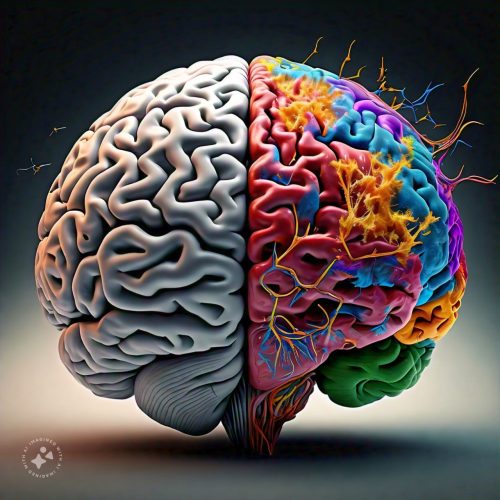In the world of sports, every moment is filled with high expectations, intense pressure, and the pursuit of perfection. But with this relentless drive to succeed, athletes often fall into a mental trap that can hinder their performance and growth: black-and-white thinking. This rigid mindset, where success and failure are seen as absolute extremes, can be a major mental limitation.
One mistake, and you may see your overall self as a failure, despite the fact that no athlete’s journey is ever defined by one moment. But there’s a way out of this unhelpful thinking pattern—by developing a more balanced perspective.

What is Black-and-White Thinking?
Black-and-white thinking, also known as all-or-nothing thinking, is when you interpret situations in absolute extremes. In this mindset, things are either perfect or disastrous—there is no in-between. For an athlete, this often looks like internal dialogue along the lines of, “If I don’t win, I’m a failure,” or, “One bad game means I’m no good at all.” This cognitive distortion creates a rigid mental framework where every setback is magnified, and every success feels like a fleeting moment that could be wiped away with one mistake.
This kind of thinking, while common, places unnecessary pressure on athletes, limiting their ability to see growth and improvement over time. It’s an unbalanced perspective that can undermine self-confidence and fuel performance anxiety.
The Emotional Toll of All-or-Nothing Thinking
At the core of black-and-white thinking is the tendency to overlook the broader narrative of your journey. One mistake or bad performance feels like the definitive moment, and it becomes easy to forget about the countless hours of practice, previous wins, or personal growth you’ve achieved. This narrow focus leads to frustration, guilt, and even shame, as athletes tie their entire sense of worth to a single outcome.
The emotional toll can be heavy. You might find yourself stuck in cycles of self-criticism or start doubting your ability to improve. Instead of seeing mistakes as opportunities to learn and grow, they become reasons to give up or to view yourself negatively. But here’s the truth: no athlete’s career or worth is defined by a single moment. To break free from this pattern, it’s essential to shift to a more balanced, realistic mindset.

The Science Behind Black-and-White Thinking
Black-and-white thinking is rooted in a cognitive distortion where the brain simplifies complex situations into absolute terms. This is often driven by the brain’s tendency to favor certainty and quick conclusions, particularly in high-pressure environments.
Neuropsychologically, this pattern engages the amygdala, the brain’s emotional center, which can trigger heightened emotional responses, such as frustration or anxiety, when things don’t go as planned. At the same time, the prefrontal cortex, responsible for rational thought and balanced decision-making, becomes less active when overwhelmed by emotional stress. This imbalance creates a mental shortcut where athletes may view themselves in extremes—either completely successful or completely failing—without acknowledging the gray areas of progress, growth, and learning. Recognizing this cognitive pattern is the first step toward shifting to a more balanced perspective.

Shifting to a Balanced Perspective
The antidote to black-and-white thinking is developing a balanced perspective. A balanced mindset allows you to see things as they truly are—not just the highs or the lows, but the full picture. It’s about recognizing that both success and failure are part of the process and that growth happens over time.
So how can you start developing this balanced view? One powerful strategy is to focus on recalling factual data across a longer time period. This means stepping back and assessing your performance with a broader lens, rather than getting trapped in the emotions of a single game, match, or training session.
Here are some practical steps you can take:
- Review Your Progress Over Time: After a tough game or performance, reflect on your journey as a whole. Have you improved in key areas? What challenges have you overcome? What wins, no matter how small, have you accumulated? Remembering your overall progress can help you balance out the emotional weight of any single setback.
- Focus on the Facts: When you’re stuck in black-and-white thinking, your emotions may trick you into believing you’re not good enough. Instead, look at the facts. How many times have you succeeded in this sport? How much have you improved over the past year? Recognize that one bad day does not erase all your hard work.
- Separate the Event from Your Identity: One mistake or poor performance does not define who you are as an athlete. Shift your focus from labeling yourself as a “failure” to acknowledging that setbacks are part of the game. This approach helps you remain grounded and stay resilient, rather than letting emotions dictate how you view yourself.
- Embrace Mistakes as Part of Growth: Elite athletes will tell you that their most significant learning experiences come from their mistakes. Mistakes are not signs of weakness; they’re opportunities to refine your skills and mindset. When you view them through this lens, the pressure of perfection lessens, and you open yourself to continuous improvement.

Why Balanced Thinking Matters for Long-Term Success
Developing a balanced perspective is essential for long-term success, both in sports and in life. Athletes who rely on black-and-white thinking often struggle to bounce back from failure, while those who cultivate a balanced mindset are more resilient and capable of overcoming challenges. When you approach your sport with an understanding that success is a cumulative process, you’re better equipped to handle setbacks and maintain your motivation.
Balancing your perspective doesn’t mean ignoring mistakes or avoiding accountability. It’s about acknowledging both the highs and the lows and keeping sight of your overall journey. By focusing on factual data and progress over time, you build mental resilience that can carry you through tough times and keep you focused on your growth, not just the results of a single event.

Conclusion: Cultivating Mental Strength Through Balance
Black-and-white thinking may seem like a common part of being an athlete, but it’s also a mental trap that can undermine your performance and self-confidence. By shifting to a balanced perspective, you free yourself from the extremes of success and failure, allowing yourself to see your journey in its entirety. Remember, one mistake doesn’t define you, and one bad performance doesn’t erase your potential.
Focus on recalling factual data over time, review your progress, and embrace your mistakes as essential to growth. When you develop this balanced perspective, you not only build mental strength, but you also set yourself up for long-term success. The next time you’re faced with a challenge, step back, breathe, and remember: progress is a journey, not an all-or-nothing game.













